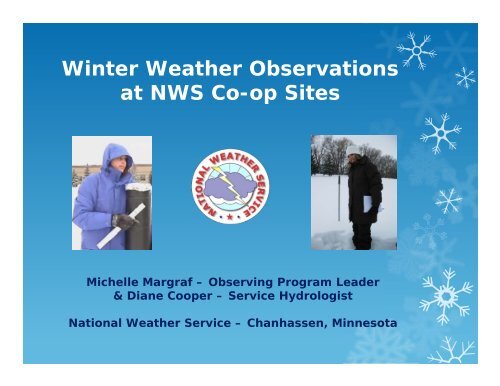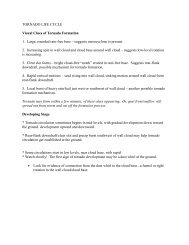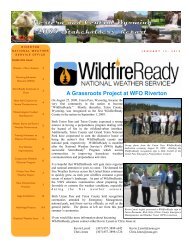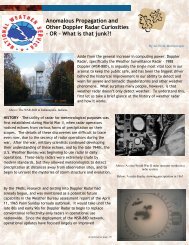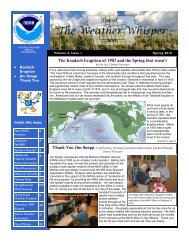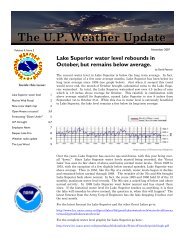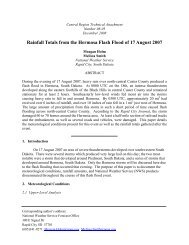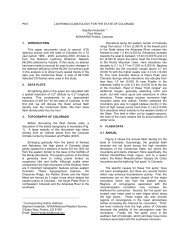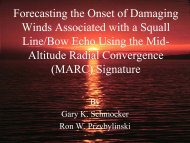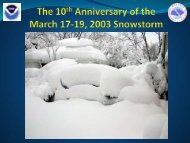Coop Observer Winter Weather Observation Training Slide ... - NOAA
Coop Observer Winter Weather Observation Training Slide ... - NOAA
Coop Observer Winter Weather Observation Training Slide ... - NOAA
You also want an ePaper? Increase the reach of your titles
YUMPU automatically turns print PDFs into web optimized ePapers that Google loves.
<strong>Winter</strong> <strong>Weather</strong> <strong>Observation</strong>s<br />
at NWS Co-op Sites<br />
Michelle Margraf – Observing Program Leader<br />
& Diane <strong>Coop</strong>er – Service Hydrologist<br />
National <strong>Weather</strong> Service – Chanhassen, Minnesota
Presentation Outline<br />
Getting the station ready for winter<br />
How to measure freezing and frozen<br />
precipitation using the rain gauge, snowboard,<br />
and snow stick<br />
How to record precipitation, snowfall, snow<br />
depth, and snow core in WxCoder<br />
How your data are used<br />
Resources available for Co-op observers
Getting Ready for the Snow Season<br />
Remove the inner tube<br />
and funnel from rain<br />
gauge<br />
Place snowboard<br />
outside, with a flag next<br />
to it<br />
Need a snowboard, flag,<br />
snow measuring stick?
Where should the<br />
snowboard go?<br />
Near the rain gage - generally good<br />
What to look for:<br />
Flat location<br />
Away from areas where drifts form<br />
Away from areas where the wind blows the<br />
ground clean of snow<br />
Away from areas where plowed snow piles up<br />
Move the snowboard if you discover a better<br />
place to measure snowfall. May want to<br />
attach flag to board.
If you have a frost tube…<br />
Pull frost tube out and turn it upside down. Make sure<br />
fluid color is yellow green from top to bottom (if not, let<br />
us know)<br />
Make sure frost tube is in dry environment. Use sponge<br />
on stick to remove any water.<br />
If cap is sticking, apply Vaseline to threads.<br />
Take measurement every<br />
Monday through spring,<br />
starting November 19 th (today)<br />
Report both the depth of frost<br />
and “depth of surface frost<br />
thawed”, even if they are zero.
Questions about preparing the<br />
station for winter?<br />
Unmute your line by pressing #6<br />
Mute your line again by pressing *6
Measuring <strong>Winter</strong> Precipitation<br />
Types of precipitation<br />
Snow<br />
Sleet/Ice Pellets<br />
Freezing Rain/Ice<br />
Rain<br />
All forms of precipitation that fall into the rain<br />
gauge during the past 24 hours are melted down.<br />
The liquid value is reported as precipitation.
Options for Melting Precipitation<br />
If no precipitation falling at observation<br />
time:<br />
Take the rain gauge inside, and either:<br />
Wait for the precipitation in the<br />
gauge to melt (may take a while),<br />
then pour melted precipitation into<br />
funnel and inner tube for measurement<br />
Or pour a measured amount of hot<br />
water into the gauge and stir.<br />
Subtract the measured amount of hot<br />
water from your final liquid<br />
measurement.<br />
Or set the rain gauge in a bath of<br />
hot water.<br />
Never melt precipitation in the<br />
microwave!
Options for Melting Precipitation<br />
If precipitation is falling at<br />
observation time:<br />
Take a bucket, trash can, or<br />
other container out to the rain<br />
gauge<br />
Dump the precipitation from the<br />
gage into the container<br />
Return the gauge back to the<br />
stand<br />
Take the bucket inside so the<br />
precipitation can be melted<br />
down and measured.
Q: There’s ice in the rain gauge, and I can’t<br />
take it inside to melt because precipitation is<br />
falling!<br />
A: Leave the rain gauge outside so it captures the current<br />
precipitation.<br />
Enter missing for today’s precipitation. Mention in remarks<br />
why precip report is missing. Report snowfall and snow<br />
depth as normal.<br />
The next day, measure the precipitation at your normal<br />
observation time (if the ice has melted), and report the<br />
amount as a 2-day precipitation total.
Q: The precipitation didn’t fall into my<br />
rain gage due to gusty winds…or my<br />
precipitation value looks really low!<br />
A: Precipitation cannot be estimated, so there are two<br />
options:<br />
1. Report the precipitation as M for missing (the<br />
only option, unless the precipitation was pure<br />
snow)<br />
2. Take a “biscuit” of the new snowfall on the<br />
snowboard (or other location) using the rain<br />
gauge, melt the snow down, measure the<br />
liquid and report the value as precipitation.
Questions about Precipitation<br />
Measurements?<br />
Unmute your line by pressing #6<br />
Mute your line again by pressing *6
Measuring 24 hour<br />
Snowfall<br />
Use snowboard so you can<br />
tell difference between<br />
newly fallen snow and old<br />
snow<br />
Use snow measuring stick to<br />
determine snowfall to nearest<br />
tenth of an inch (i.e. 0.4” or<br />
1.3”)<br />
Wipe snowboard clean after<br />
daily measurement, and<br />
place it on top of existing<br />
snow (i.e. level with<br />
surrounding snow) to reset<br />
board for next day<br />
Can flip board over, or take it<br />
inside, to remove frozen<br />
precip
Q: My snowboard was wiped<br />
clean by the wind!<br />
A: Snowfall can be estimated. It’s important to<br />
note in remarks when snowfall is estimated.<br />
Is there another location on your property (i.e. a<br />
driveway, sidewalk, deck, picnic table) you can use to<br />
measure/estimate the new snowfall?<br />
If not, call us with your precipitation total, and we can<br />
help determine a snowfall estimate for your station.<br />
(Snowfall to precip ratio is NEVER 10 to 1!)<br />
Don’t report zero for snowfall if it snowed!<br />
Zero means that it didn’t snow.
Q: The snow melted off my snowboard<br />
before I could measure it.<br />
A: Do you know how much snow was on your<br />
board before it started to melt? If so, report the<br />
maximum depth of snow on your board during the<br />
past 24 hours as your snowfall.<br />
If you’re not sure how deep the snow got, and the<br />
snow melted before your observation time, report<br />
“M” (missing). Mention in remarks that the snow<br />
melted before it could be measured.<br />
Don’t report zero for snowfall if it snowed!<br />
Zero means it didn’t snow.
Q: What if it snowed, but nothing<br />
accumulated on the ground?<br />
A: If the snow melted as it hit the ground<br />
(common when the ground is still warm in the fall),<br />
report a “T” (trace) for snowfall.<br />
Flurries (even if they don’t reach the ground) are<br />
considered precipitation and snowfall. Flurries are<br />
reported as both a trace of precipitation and<br />
a trace of snowfall.
Q: The wind blew snow onto<br />
my snowboard. Does that<br />
count?<br />
A: Blowing and drifting snow does not count as<br />
new snowfall.<br />
If it didn’t snow during the past 24 hours, and you<br />
find snow on your snowboard, disregard the snow<br />
on the board, wipe the board clean, and report<br />
zero for snowfall.<br />
You can report blowing and drifting snow in<br />
remarks.
Questions about snowfall measurements?<br />
Unmute your line by pressing #6<br />
Mute your line again by pressing *6
Measuring Snow Depth<br />
Best locations to measure snow depth<br />
Relatively flat area not subject to drifts caused by<br />
buildings, fences, or plowing<br />
An area that shows a representative amount of<br />
snow through the winter (i.e. not the highest or<br />
lowest depth of snow on your property).<br />
You can move your snow depth measurement area<br />
during the winter if you find a more representative<br />
location.<br />
Measure the snow depth in 4-6 locations.<br />
Average the measurements together to get the<br />
official snow depth (reported to the nearest<br />
inch).<br />
Example:<br />
5” + 3” + 8” + 10” + 6” + 7” = 6.5” average.<br />
Would be reported as 7” snow depth
If the bare spots cover less than 50% of snow depth<br />
area, average the bare spots with measurements from<br />
areas that have snow, and report the average value as<br />
your snow depth.<br />
If the bare spots cover more than 50% of area,<br />
regardless of how deep the snow is in the rest of the<br />
snow measuring area, report a trace for snow depth.<br />
Don’t report 0 snow depth until all but the manmade<br />
piles of snow are gone.<br />
What if<br />
there<br />
are<br />
bare<br />
spots?
Co-op Daily <strong>Observation</strong>:<br />
3 Elements Reported During <strong>Winter</strong><br />
Season<br />
October 1 st through April 30 th make sure<br />
to report each day:<br />
Precipitation<br />
Snowfall<br />
Snow Depth<br />
Even if it’s zero!<br />
Snowfall and snow depth reports are optional after April 30 th .
Questions about Snow Depth<br />
Measurements?<br />
Unmute your line by pressing #6<br />
Mute your line again by pressing *6
Extra Credit <strong>Observation</strong>:<br />
Snow Core<br />
Snow Core = amount of water in the snow pack<br />
Used to gage risk of flooding when snow melts<br />
Measurement taken once a week (on Sunday or<br />
Monday) when 2 or more inches of snow is on the<br />
ground<br />
Rain gage is turned upside down and pressed down into<br />
snowpack in location equal to the snow depth. Snow is<br />
taken inside, melted down, and the liquid amount is<br />
reported as the snow core to the nearest tenth of an<br />
inch (i.e. 1.32” of water would be rounded to 1.3”)
4<br />
1<br />
3<br />
2
Tips for Snow Cores<br />
Try to avoid areas that were sampled before, if possible.<br />
The snow density in a previously sampled spot will not<br />
be representative of the overall snowpack<br />
If you see an ice layer in the snow core, note the<br />
thickness, where it is in the snow pack (top, middle,<br />
bottom), and if there are bubbles in remarks.<br />
If you see grass in your snow core, you know you have a<br />
good sample (i.e. reached the ground)<br />
If ice is at the bottom of the snow pack, and you can’t<br />
include it in your measurement, tell us in remarks how<br />
thick the ice layer was below the snow. We can estimate<br />
the water in that layer if we know how thick the ice is.
Questions about Snow Core Measurements?<br />
Unmute your line by pressing #6<br />
Mute your line again by pressing *6
How to Report <strong>Winter</strong><br />
Measurements in WxCoder
Reporting<br />
Precipitation,<br />
Snowfall and<br />
Snow Depth in<br />
WxCoder<br />
Using<br />
Monthly<br />
Page
Multi-day<br />
precipitation,<br />
snowfall, and<br />
snow depth
How to report snow core in WxCoder<br />
Must use daily entry page to transmit snow core data<br />
Leave snow core blank unless you<br />
have a snow core to report!
Questions about WxCoder?<br />
Unmute your line by pressing #6<br />
Mute your line again by pressing *6
When to report?<br />
Enter your daily weather report in WxCoder as close to<br />
your observation time as possible.<br />
We can’t share data from your community, or use it in maps or<br />
weather/river models, until we receive it.
Sharing Your Data With Others<br />
Daily <strong>Weather</strong> Maps (if received same day)<br />
Storm Event Summaries (if received by end of storm)<br />
Also posted on state, regional, and national climate sites<br />
(as soon as data are received)<br />
You can also call us with intermediate reports during<br />
significant winter storms (i.e. when you receive new snow<br />
amounts like 6”, 9”, 12”, your storm total snowfall, etc).<br />
Please report dangerous weather conditions like whiteouts,<br />
blowing snow covering roads, ice accumulations, etc. We pass<br />
these reports onto law enforcement, and issues warnings or<br />
advisories to warn others.<br />
You are the trained weather observer for your community,<br />
so your reports are the official total! We need the official<br />
total as soon as it’s available.
<strong>Winter</strong> <strong>Weather</strong> Observing Resources<br />
National <strong>Weather</strong> Service <strong>Observer</strong> Hotline<br />
(available 24 hours a day): 1-800-692-2110<br />
(unlisted number)<br />
NWS Co-op <strong>Observer</strong> Quick Reference Guide (PDF)<br />
Snow Measuring DVD (25 minutes long)<br />
<strong>Winter</strong> Co-op Newsletter<br />
Snowboard, Snow Measuring Stick, Snow Flags<br />
Copy of this presentation (online)<br />
Contact Michelle Margraf at 952-368-2520 or<br />
michelle.margraf@noaa.gov


